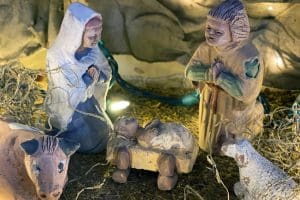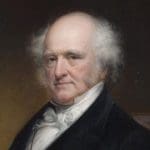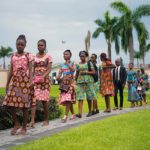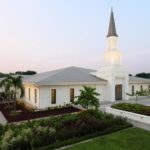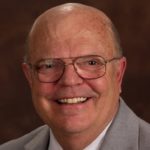We’re racing through the farmlands of Northwest Finland, photographing country churches along the backroads, and I’m catching a bit of my wife’s enthusiasm for the hobby of finding and photographing each and every pauper sculpture to be found in the old rural chuchyards of Lutheran Finland.
This just might be the most looked-forward-to and needed vacation of our lives so far. And driving through this time-frozen section of an otherwise progressive, high-tech country is doing its restorative magic for both of us.
Pauper sculpting was a mid-19th century phenomenon, and the paupers, or vaivas ukkot, were carved out of wood, usually to a scale of about three-quarters of human size, painted with full clothing in a lifelike way, and housed in one of three or four standard spots on the churches’ grounds or entryways. Sometimes the paupers would have an obvious deformity, like an amputated foot, but the local sculptor/painter was free to create a figure of his own choosing. Somewhere on the chest of each pauper was carved a vertical slot, large enough to accept all the coinage of the day, and alms for the poor were collected in receptacles housed inside the chest cavity of the wooden paupers.
A century later, other ways were devised to raise these needed funds, and many of the wooden paupers fell into disrepair. Some were removed. Today we are finding quite a few to be in recently restored condition, thanks to attention being directed to this folk-art treasure by afficionados such as the aforementioned Maisa Simpson.
By the afternoon, we’re in a Swedish-speaking district of Finland, and while Maisa photographs, I wander up to the Church, taking a look at the announcement boards. After a series of typical but all-Swedish announcement sheets, one multi-colored concert-sized poster announces a nation-wide Finnish Lutheran church dance. The headline is in English: “Eternal Souls Disco.” I translate this into Finnish for the party we’re traveling with, and everyone laughs.
“Wasn’t it easier,” I say quietly to Maisa, “when in our church Brigham Young simply explained that wholesome dance was an important component of proper recreation? No need to try to turn it into an improbable alternative worship exercise such as ‘Eternal Souls Disco’.”
We climb back in the car and someone asks for the radio. A Finnish modern rock station is on FM preset number three, and my mind is jarred again: it sounds like a group of Finns singing in English over an acoustic rock beat, no big deal so far, but the text, of all things, is an old hymn, “by the waters of Babylon, where we sat down.how can we sing the songs of God in a strange land?”
I mentally check out of the others’ conversation and slip into a mental game of solitaire: a zone, a debate for one, struck by having heard this hymn text where it was least expected, and where it probably didn’t belong. Does it ever do any good to present religious thought in a profane setting? A spiritual lyric in a pop or a rock setting?
This question, along with the elusive definitions needed for any kind of an answer, has weaved through my life for years. Can there ever be an end to the debate? I’m thinking probably not, and then it strikes me that this very instance of a religious text in an improbable rock setting has involved me in deep thought.
Singing the songs of God in a strange land. In a way, I tell myself, doesn’t that old hymn talk about me-who I am, how I’m defined, what I’ve done? At seventeen I was strumming and singing my arrangements of American and Finnish folk songs and Finnish hymns in a trio with two host-family Finnish brothers. Officially, I was an exchange student representing America, and my being a young Mormon boy hadn’t been obvious to my hosts prior to my arrival. It came upon them gradually, via Word of Wisdom issues at mealtimes or at parties. My California address hadn’t telegraphed my religion the way a Utah address might have. It was quite a matchup, putting the Mormon kid from California into the home of a central-Finnish rural Lutheran rovasti, or regional pastor. Unbeknownst to me, Henry Matis, president of the Finnish Mission of the LDS Church, was just hitting his stride, the pastor turned out to be more aware of the Latter-day Saints than I could have known.
And he and his wife loved the music I arranged for this temporary “brothers group,” and the pastor dragged me, my guitar, and his two oldest sons to every possible church and family event in the back seat of the big black four-door EMW, the East-German sister brand of the West-German BMW. (This family car, I stress, was not the ultimate driving machine.)
One Saturday, as the family got up to leave after their weekly vespers, or devotional, the pastor motioned for me to stay. It was the only one-on-one discussion we would have. Apparently mellowed by the three-part music we’d been singing, he told me, in very broken, but deliberate English, that he was aware of my Church, and he wanted me to know that he had just given permission for the Mormons to microfilm the many generations of genealogical records contained in his church offices. Dacades later Henry Matis would tell me Rovasti Tarjamo, my host father, had been an important early friend to our Church, one of the first to trust us, and his leadership caused several other priests to throw open their doors to the Church’s early pioneering family history initiative in Finland.
Four years later I was a missionary serving in Finland. A portion of my time went into music making, and I found that many, including the mission president, whose wife was a violinist from the Utah Symphony, and including the local Finnish leaders, had no doubt about the power of music, or the efficacy of our singing the songs of God in this strange land, but from time to time it would be suggested that real men knocked on doors (and I actually did a lot of that, too). As time went on, I began to question if somehow I had indeed squandered the musical portion of my mission, and I worried that some of the music I’d presented hadn’t even been specifically the songs of God. Some had just been songs, presented in a positive, uplifting context, by the people of God: youth, musical stripling warriors. I did music in Finland not only during, but even after my mission.
By mid career, when I was recruited by BYU to join forces with their School of Music, to write, arrange, and produce music for the touring shows that were linked to the Church’s broader objectives, and to help identify and train the next generations of Mormon music makers, I was essentially past any feelings of ambivalence. In revisiting my patriarchal blessing, I understood that organizing and singing the songs of God in strange lands was essentially foreordained, part of my life’s overall mission plan.
But as the BYU years went on, that sureness, that sense of purpose would ebb and flow, wax and wane, run hot and cold.
And then on one of those tired days on the road for BYU in Vernon, British Columbia, when I found myself wondering what if anything my meager talent had contributed, Punnu (Finnish nickname), an old friend of my wife’s and an acquaintance of mine, heard we were in the area with the BYU Young Ambassadors and drove a long way to sit and reminisce with us. One of the first serious questions we asked her had to do with the health of her sister, Vaakku (also a nickname, real name: Eeva Kaarina), who we’d heard had been near death. “It’s true,” said Punnu, in Finnish. “Nothing the doctors could do, nothing we could do as the family, could reverse her condition. Finally we became resigned that we were really going to lose her.” And then she went on to tell us she began to sing to her sister. They’d been a musical family, and Punnu said she sang all the songs she and her sisters had sung together in school, at home, in Church. Nothing helped.
“Finally,” she continued, turning her gaze to me, “I tried singing some of your songs from Johnnyn Tarina, from our Mutual conference when we were kids.
Vaakku began to stir, there seemed to be some activity under her eyelids, and that was the turnaround moment.”
Maisa answered with all the right things, but I was getting choked up. I just squeezed Maisa’s hand, stood up to go in and soundcheck the band for the night’s show, and disappeared through the theater door.
(Johnnyn Tarina [The Tale of Johnny] was a heartwarming musical-true story-about a Mormon soldier from Arizona who had been a casualty in World War II. It was presented by the youth of the Finnish Mission at a conference held in Tampere, Finland, in 1964 with book and music by Ron Simpson, Finnish lyrics by Maisa Tuominen [now Maisa Simpson]. At the time, I was a temporary student at the Sibelius Academy of Music in Helsinki, Finland.) So how shall we sing the songs of God in a strange land? Any way we can. Any way they’re given to us. Any way they’ll reach someone. And any way they’ll complement the overall objectives of the Church in that setting.
Once again I’ve discovered myself slipping into this solitary monologue with a sense of personal doubt but after some further review have ended up mentally shouting thank you. Thank you for allowing a marginally talented music maker to serve, even to sing the songs of God, the songs of Zion, in strange lands, and above all, to be told, more than once, that these little songs have made a difference. If I started out as the musical pauper today, then my little coin box has been filled to overflowing.
P.S. Oh, and about these Finnish nicknames: Maisa is a nickname too. Her real name is Marja-Liisa. Me? No, I’m just Ron. Well, to be totally honest, most of our Finnish extended family relatives call me Roni, and a few very old friends, including my wife, zeroing in on my last name, call me Nipsu. Tip: don’t you go trying that one.








